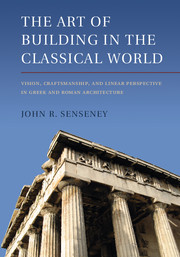 The Art of Building in the Classical World
The Art of Building in the Classical World Book contents
- Frontmatter
- Contents
- List of Figures
- Preface
- Note on Dates and Translations
- Abbreviations
- INTRODUCTION: CHALLENGES OF ANALYSIS AND INTERPRETATION
- 1 THE IDEAS OF ARCHITECTURE
- 2 VISION AND SPATIAL REPRESENTATION
- 3 THE GENESIS OF SCALE DRAWING AND LINEAR PERSPECTIVE
- 4 ARCHITECTURAL VISION
- Excursus: Envisioning Cosmic Mechanism in Plato and Vitruvius
- Appendix A Analysis of the Dimensions of the Blueprint for Entasis at Didyma
- Appendix B Analysis of the Hypothetical Working Drawing for Platform Curvature at Segesta
- Appendix C Analysis of the Hypothetical Working Drawing for Platform Curvature in the Parthenon
- Notes
- References
- Index
Appendix A - Analysis of the Dimensions of the Blueprint for Entasis at Didyma
Published online by Cambridge University Press: 07 October 2011
- Frontmatter
- Contents
- List of Figures
- Preface
- Note on Dates and Translations
- Abbreviations
- INTRODUCTION: CHALLENGES OF ANALYSIS AND INTERPRETATION
- 1 THE IDEAS OF ARCHITECTURE
- 2 VISION AND SPATIAL REPRESENTATION
- 3 THE GENESIS OF SCALE DRAWING AND LINEAR PERSPECTIVE
- 4 ARCHITECTURAL VISION
- Excursus: Envisioning Cosmic Mechanism in Plato and Vitruvius
- Appendix A Analysis of the Dimensions of the Blueprint for Entasis at Didyma
- Appendix B Analysis of the Hypothetical Working Drawing for Platform Curvature at Segesta
- Appendix C Analysis of the Hypothetical Working Drawing for Platform Curvature in the Parthenon
- Notes
- References
- Index
Summary
See Chapter 3 and Figures 60, 62.
Measured from its central axis, the total radius of the blueprint's shaft (f-i) is ca. 1.01 m, with differences of only 1.5 mm between the widths of the top and bottom measurements. The top of the shaft where the arc intersects the chord measures 84.3 cm +/−0.1 cm (this portion of the drawing is not preserved, hence the uncertainty of .8429–8431 m for the restoration). Vertically, the drawing divides into the .3128 m base shown at 1:1 scale, and the 1.1857 m distance to the top of the drawing at d65 shown at 1:16 scale, resulting in a total height of 1.4985 m. The reduced-scale portion above the base measures 1.1232 m up to the level of the intersection of the arc and chord at d61a. At this level, the horizontal line does not conform to the regular intervals of dactyls of 1.85 cm, appearing instead 1.25 cm above d61, which Haselberger suggests may represent 2/3 of a single dactyl. As Haselberger concludes, the drawn shaft's total height to this point is therefore 60 2/3 dactyls, roughly corresponding to the built shaft's height of 60 3/4 feet.
The significance of this dimension becomes apparent in relation to the other dimensions within the drawing. As b, its relationship to e as the total height of the drawing from the bottom of the base to d65 is an integral 3:4 ratio: (1.123 m/3) × 4 = 1.4973 m, a negligible difference of −1.2 mm from 1.4985 m as measured in the drawing.
- Type
- Chapter
- Information
- The Art of Building in the Classical WorldVision, Craftsmanship, and Linear Perspective in Greek and Roman Architecture, pp. 189 - 190Publisher: Cambridge University PressPrint publication year: 2011


